When the weather turns colder in autumn and winter, it’s the perfect time to cozy up inside with a cup of tea and a roaring fire. Unfortunately, the bugs outside find your home cozy, too. If you’re not vigilant, you may have a host of unexpected (and unwanted!) guests at your holiday party.
Keep reading to discover the 11 different bugs that may try to enter your home this winter and how you can prevent them from getting in.
Why Do Bugs Travel Inside for Winter?
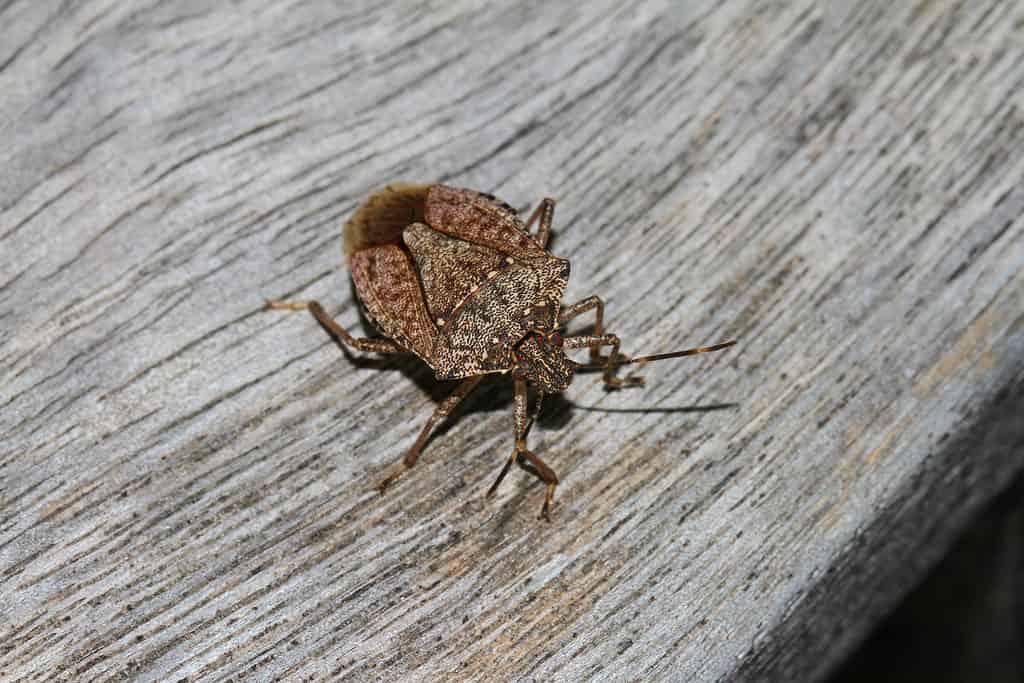
Stink bugs are one of 11 types of insects that invade homes in the winter.
©Ruth Swan/Shutterstock.com
Winter weather can become unpredictable fast. With the potential for strong winds, snow, sleet, heavy rains, and freezing temperatures, the outside world becomes a harsh and unforgiving place for tiny bug bodies.
Your home, however, provides a stable and relatively safe environment throughout the cold winter months. It’s also a great source of food — which bugs appreciate as the resources outside become more scarce.
Bugs will travel into your home in a variety of ways. They may use the door and crawl through gaps in the frame; they could do the same to windows with poor caulking. Cracks in your foundation or in your basement allow enough space for bugs to invade. Another avenue is indoor/outdoor connections like cables, pipes for plumbing, and air conditioning and heating. If these wires, pipes, and vents aren’t sealed properly, they act as an easy way for bugs to get to the warmth of your kitchen and living room quickly.
Finally, clutter and food waste act as beacons to hungry, cold bugs. The more food you have lying around uncovered, the more bugs you’ll attract.
11 Bugs That May Try to Enter Your Home This Winter
Of the thousands of species of bugs, the 11 listed below are some of the most common homeowners will find trying to invade in the winter months. While some are harmless, others can secrete staining liquid, transmit disease, or create a hard-to-get-rid-of infestation.
Box Elder Bugs
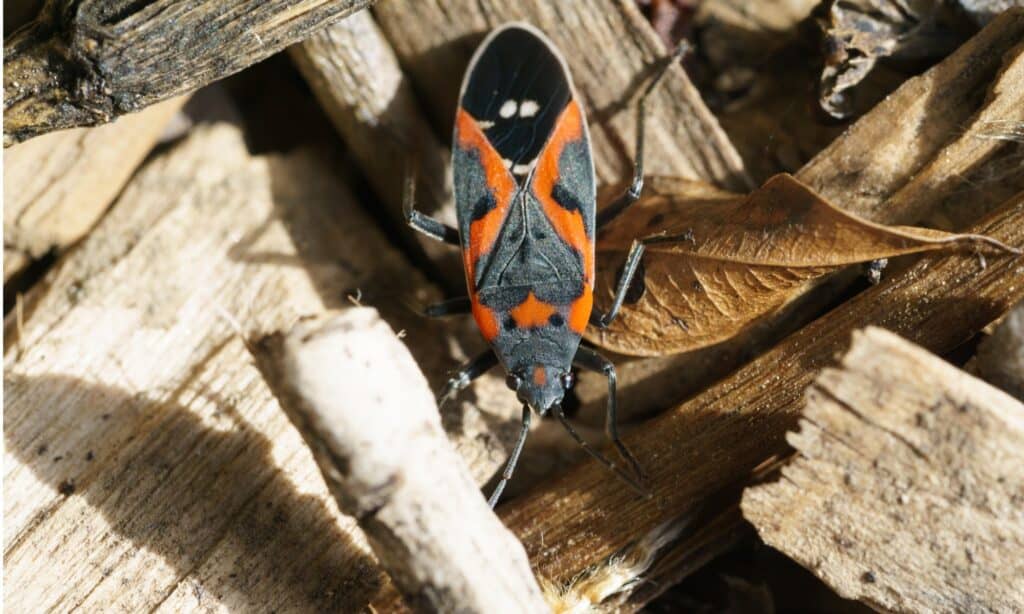
Boxelder bugs have flattened oval-shaped bodies with tapering at the end.
©iStock.com/fusaromike
You may mistake these for lightning bugs at first glance, but the box elder bug has a distinct red or orange marking on its wing to stand out. Box elder bugs are relatively harmless — they don’t transmit disease, bite, or cause structural damage to your house. They do, however, secrete a liquid when they’re stressed that can stain walls.
Box elder bugs, named for the tree they feed on, will try to overwinter as much as they can. Only adults can survive the season and remain attracted to heat sources. They’ll gain entry to your home through the cracks in its foundation or gaps in window and door sealings. You may see a cluster of them on the sunny side of your home on warmer days.
Asian Lady Beetles

Asian lady beetles, though similar to ladybugs, are a different species.
©iStock.com/DE1967
Like the box elder bug, Asian lady beetles are sometimes mistaken for another bug: the ladybug. Alas, these two insects are completely different animals. The Asian lady beetle has an orange color to their shell rather than red. It also tends to have more black dot variety on its shell; some have close to 19 dots while others have none at all.
Thankfully, the Asian lady beetle remains a nuisance more than a cause for concern. While several years ago viral information went around social media informing pet owners that Asian lady beetles can harm dogs, the American Kennel Club and other experts have confirmed these bugs don’t pose harm to humans or pets. Asian lady beetles also do not cause structural damage, nor do they lay eggs or breed inside. They simply enter your house in an attempt to overwinter.
House Spiders
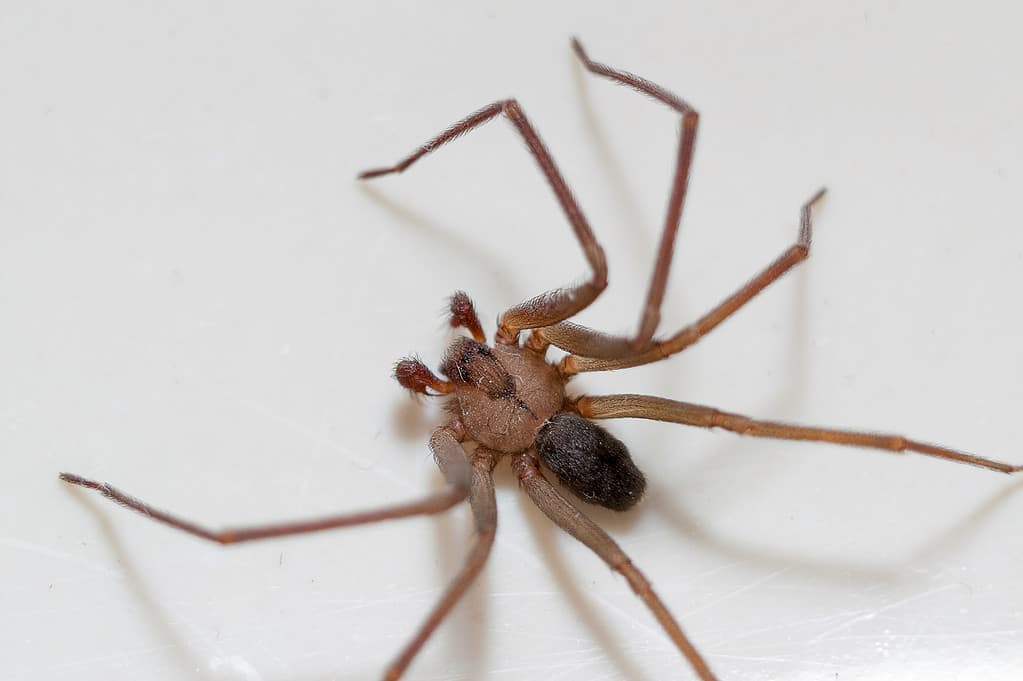
Brown recluse spiders will move into your home during the winter — unlike other types of spiders.
©benjaminjk/iStock / Getty Images Plus via Getty Images
Spiders may have made themselves known in early fall and as winter comes around, you see them less. The reality is simple: outside spiders who don’t come into your home are in diapause, or an intentional period of development that slows down bodily functions to weather the cold. In diapause, they “hunker down” in their hiding places to wait for warmer days to hunt.
When you do see a spider in the house, it’s time to bust a myth: spiders don’t migrate in droves into your house when it gets cold. Chances are, the spider you’re seeing has been in your home for a bit and you’re only seeing it out of coincidence. Spiders like to live in dark, undisturbed parts of the home and stray from their space to hunt for food (like insects) or find a mate.
The only exception to the rule: the brown recluse spider. This spider will seek warmth and shelter in the winter months and may move into your basement, attic, or garage as frost descends.
Stink Bugs

Brown marmorated stink bugs (
Halyomorpha halys) search for a place inside to diapause.
©Light Capturing/iStock / Getty Images Plus via Getty Images
Unlike spiders, stink bugs seek out building interiors for diapause in the winter. These spaces — including attics, baseboards, siding, and basements — provide a safe place for the bug’s inactivity. As they choose not to hunt and slow their functions down, stink bugs simply need a warm and quiet corner to rest.
Unfortunately, the generosity of a stink bug will become a nuisance for you. Stink bugs will share their hiding place with others, which can lead to a mild infestation (or at least a lot of cleanup). Once they find a good spot, they’ll release a pheromone that attracts other stink bugs to the site as well.
Stink bugs don’t bite people or animals, nor do they breed inside homes. When they release their pheromone, however, it can aggravate some humans’ allergies.
Ants
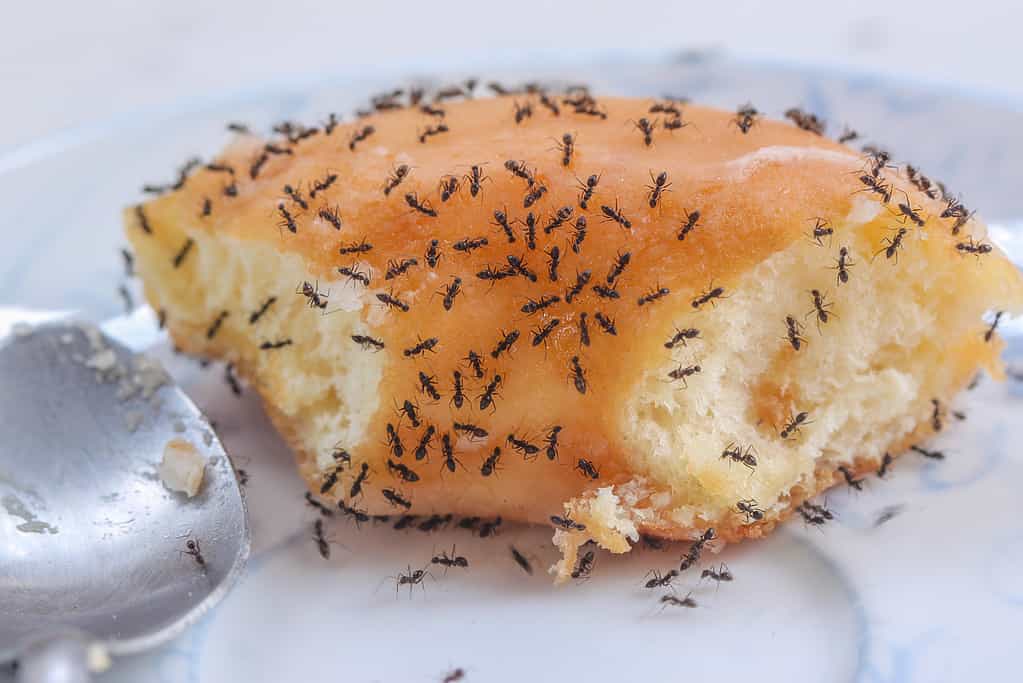
If ants can find a warm place that is relatively safe with food and water sources, they will come inside.
©DARUNEE SAKULSRI/Shutterstock.com
While some colonies choose to overwinter in their burrows, it’s not uncommon for a swarm to accidentally end up inside.
During the winter, ants need to find a place with enough warmth to keep their bodies alive. Once temperatures drop below 75 degrees Fahrenheit, winter preparations begin. The burrows created outside during winter look for leaves, debris, or other natural blankets ants can use for insulation.
If a warm day tricks the colony or their burrow isn’t sufficiently warm enough, ant scouts may find a way into your home and bring their community inside. The most common places for ants to infest in the winter are walls, floors, cabinets, and under appliances. Ants need food, water, and warmth to survive, so if you can remove even one of these factors, your house becomes less likely to host a colony.
Roaches

Cockroaches will invade your home’s nooks and crannies to safely “hibernate,” or diapause.
©iStock.com/Wi6995
Different types of cockroaches will find their ways inside. American cockroaches tend to enter diapause and may do so in the safety of the nooks and crannies of your house. German cockroaches, on the other hand, will invade southern states with tropical climates year round.
Pest experts consider the American cockroach as the number one house-infesting cockroach in the United States, especially in winter. Pestworld.org even mentions that they “mass migrate into homes.” Both American and German cockroaches will breed indoors during the winter in wall cracks and dark, cluttered corners of your home.
Black-Legged (Deer) Ticks
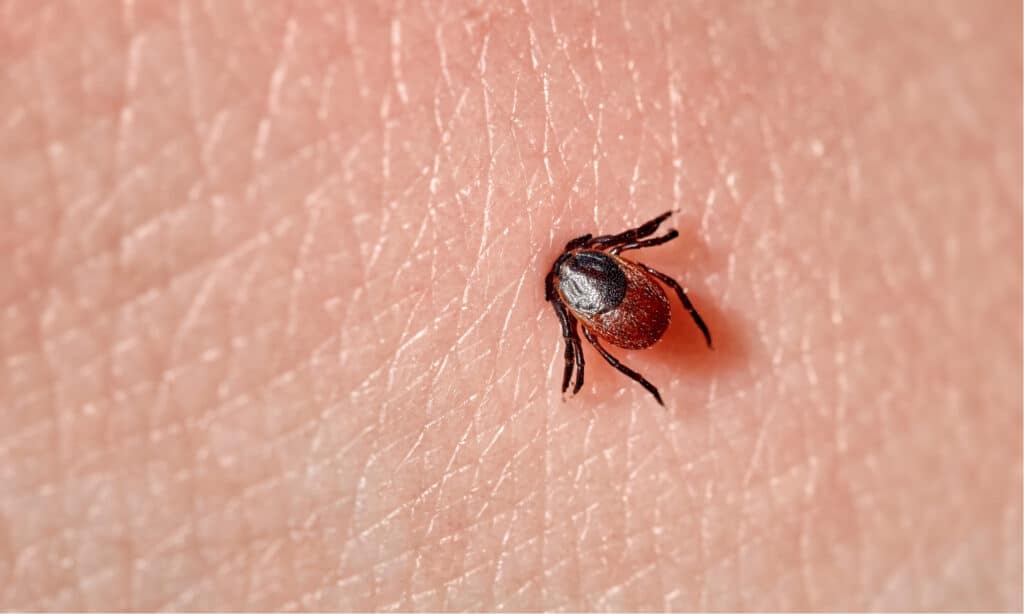
Deer ticks can survive in the winter.
©Evgeniyqw/Shutterstock.com
Unfortunately for avid hikers and dog walkers, ticks don’t often die when the first frost sets in. While ticks won’t seek active warmth in your home, they will seek a blood meal from your dog or cat when they go outside.
Until the ground is frozen and covered in snow, black-legged ticks remain active. The first frost actually signals the prime feeding season for black-legged ticks because their prime prey — white-tailed deer — move around during this season. If they can’t find deer, they’ll happily feed on your dog, cat, or you.
When hiking, taking your dog on a walk, or just spending time outside in grass, check yourself and your pets for ticks before coming back inside.
Ladybugs

Ladybugs must find shelter in the winter or they’ll perish from the cold.
©Ger Bosma Photos/Shutterstock.com
Like Asian lady beetles, ladybugs can’t weather the cold of winter. Instead, they seek out warmth and bring their friends to undergo diapause in your home. This insect form of hibernation can last as long as nine months depending on how much foraging the ladybug did for itself over the previous months.
Ladybugs will gather in droves to sleep in your home. They enter as other insects do — through cracks in the foundation, gaps in window and door seals, or through openings like chimneys and loose pipe caulking. If you find a group of ladybugs sleeping in your home and want to take them outside, you may kill them accidentally, as their bodies cannot weather the cold.
Termites

Termites can burrow 40 inches into the earth during the winter.
©gunawand3570/Shutterstock.com
While termites tend not to swarm between December and February, based on experience from Terminix technicians, they can stay active in your home if they’re already there. That’s right — if you have termites already in your foundation or walls, the temperature change won’t affect the termites’ daily routine all that much.
Termites dig deeper into the ground during winter to find warmer soil. These tests and tubes can reach almost four feet in depth! Just because it’s cold doesn’t mean termites are dead. They will stay active year-round.
Silverfish
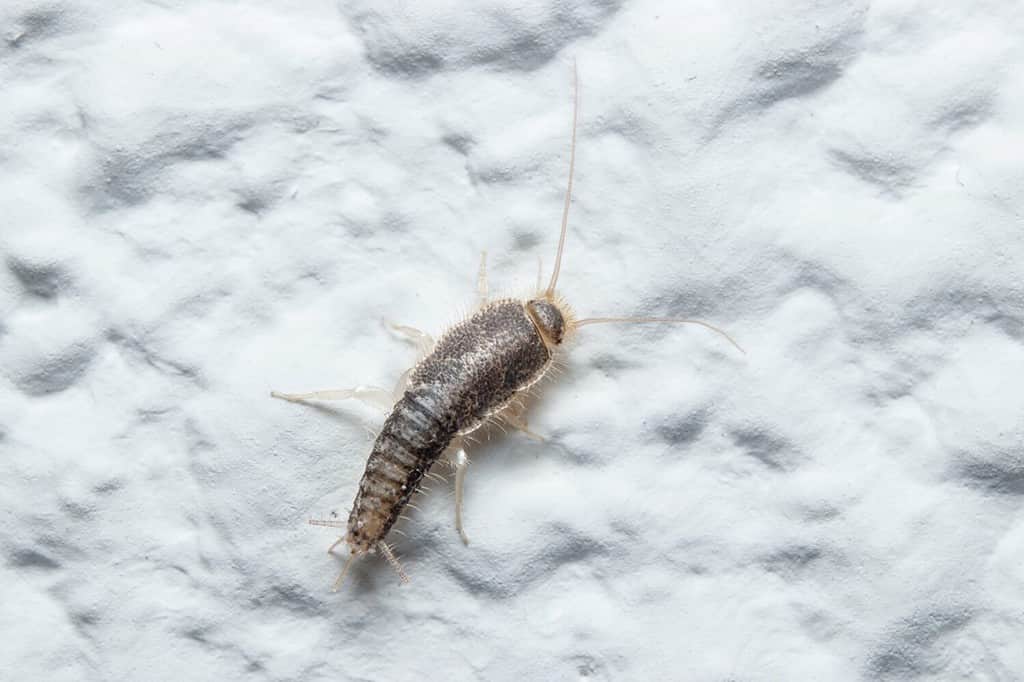
The best way to avoid a silverfish infestation is to remove food and shelter sources.
©JorgeOrtiz_1976/Shutterstock.com
The ancient-looking insect, the silverfish, can thrive in the winter. Unlike some other bugs that enter your home simply for warmth, silverfish want to move in. A female silverfish can lay up to 3,500 eggs — so infestations can get out of control quickly.
Silverfish thrive in spaces that are cold, dark, and damp. This might be basements, kitchen and bathroom sinks, or attics as well as cracks in your floor.
To ward these creepy crawlies off during winter months, you’ll want to remove any food crumbs, get rid of clutter, seal the cracks and crevices of your home to the outside, and vacuum regularly.
Fleas

Unfortunately, fleas can make it through the winter.
©Mironmax Studio/iStock via Getty Images
Just like ticks, fleas don’t die off in winter. Their bodies slow down during the colder months outside, but once they warm up indoors, they’re back to being a nuisance. Furthermore, flea larvae can still hatch outside in the winter to begin their life cycle.
Once you have a flea infestation, it’s difficult to get rid of. Washing and fumigating in winter is all the more frustrating — so the best method of defense is prevention. Make sure your dogs, cats, and other pets remain on flea and tick prevention medication year-round so they can stop the life cycle in their tracks and keep your home flea-free.
How to Keep Bugs Out of Your Home
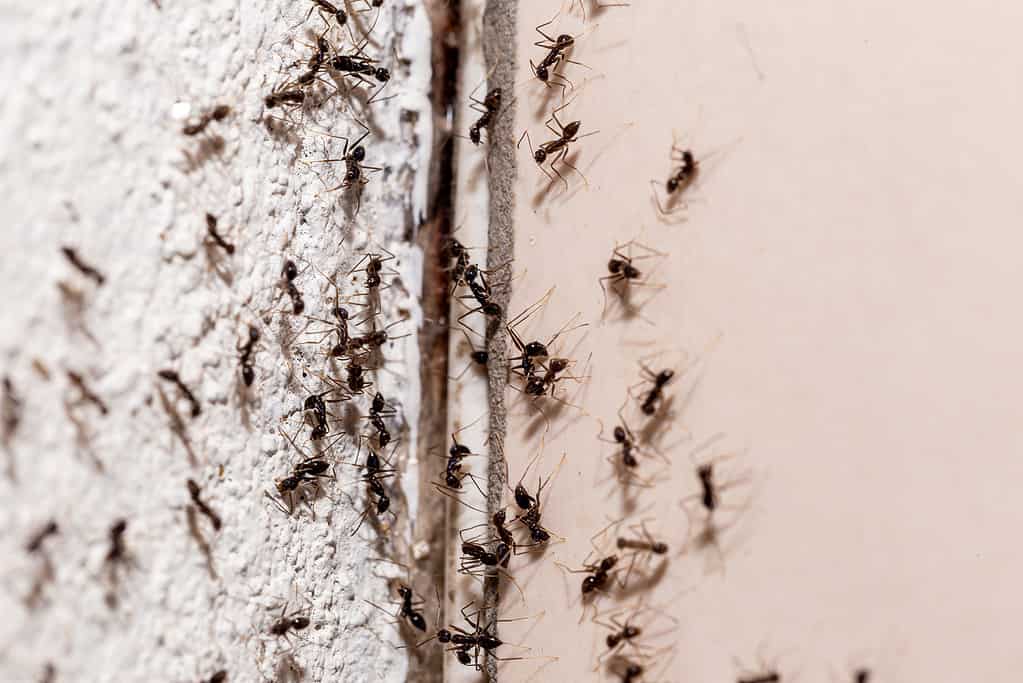
While you can’t guarantee
nopests in winter, you can attempt to keep most of them out.
©RHJ/iStock via Getty Images
Pest-proofing your home can’t guarantee you won’t find a single bug — but it will significantly reduce the ways bugs can get into your home this winter. Some common pest-proofing actions you can take include:
- Sealing entry points.
- Being mindful to throw away clutter.
- Getting rid of leaky faucets that cause mold.
- Raking your yard.
Pests are looking for safety when they enter your home in the winter. They want to find a warm, undisturbed place near a reliable food source to survive the cold months. By removing access points, keeping your home clean, and reducing the number of hiding places both inside and outside, you’ll create an inhospitable place for bugs to go.
Remember that experts and pest technicians will provide the best treatment and prevention plans. If you’re facing an infestation or trying to ready your home for winter, consider talking to your local extermination company about your options.
The photo featured at the top of this post is © TacioPhilip/iStock / Getty Images Plus via Getty Images
Thank you for reading! Have some feedback for us? Contact the AZ Animals editorial team.






